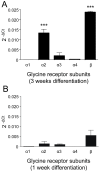Differentiated human midbrain-derived neural progenitor cells express excitatory strychnine-sensitive glycine receptors containing α2β subunits
- PMID: 22606311
- PMCID: PMC3350492
- DOI: 10.1371/journal.pone.0036946
Differentiated human midbrain-derived neural progenitor cells express excitatory strychnine-sensitive glycine receptors containing α2β subunits
Abstract
Background: Human fetal midbrain-derived neural progenitor cells (NPCs) may deliver a tissue source for drug screening and regenerative cell therapy to treat Parkinson's disease. While glutamate and GABA(A) receptors play an important role in neurogenesis, the involvement of glycine receptors during human neurogenesis and dopaminergic differentiation as well as their molecular and functional characteristics in NPCs are largely unknown.
Methodology/principal findings: Here we investigated NPCs in respect to their glycine receptor function and subunit expression using electrophysiology, calcium imaging, immunocytochemistry, and quantitative real-time PCR. Whole-cell recordings demonstrate the ability of NPCs to express functional strychnine-sensitive glycine receptors after differentiation for 3 weeks in vitro. Pharmacological and molecular analyses indicate a predominance of glycine receptor heteromers containing α2β subunits. Intracellular calcium measurements of differentiated NPCs suggest that glycine evokes depolarisations mediated by strychnine-sensitive glycine receptors and not by D-serine-sensitive excitatory glycine receptors. Culturing NPCs with additional glycine, the glycine-receptor antagonist strychnine, or the Na(+)-K(+)-Cl(-) co-transporter 1 (NKCC1)-inhibitor bumetanide did not significantly influence cell proliferation and differentiation in vitro.
Conclusions/significance: These data indicate that NPCs derived from human fetal midbrain tissue acquire essential glycine receptor properties during neuronal maturation. However, glycine receptors seem to have a limited functional impact on neurogenesis and dopaminergic differentiation of NPCs in vitro.
Conflict of interest statement
Figures





Similar articles
-
Functional and molecular analysis of GABA receptors in human midbrain-derived neural progenitor cells.J Neurochem. 2008 Nov;107(4):1056-69. doi: 10.1111/j.1471-4159.2008.05688.x. Epub 2008 Sep 15. J Neurochem. 2008. PMID: 18796004
-
Glutamate receptor properties of human mesencephalic neural progenitor cells: NMDA enhances dopaminergic neurogenesis in vitro.J Neurochem. 2009 Oct;111(1):204-16. doi: 10.1111/j.1471-4159.2009.06315.x. Epub 2009 Jul 30. J Neurochem. 2009. PMID: 19659571
-
Calcium, Sodium, and Transient Receptor Potential Channel Expression in Human Fetal Midbrain-Derived Neural Progenitor Cells.Stem Cells Dev. 2018 Jul 15;27(14):976-984. doi: 10.1089/scd.2017.0281. Epub 2018 Jun 14. Stem Cells Dev. 2018. PMID: 29779467
-
Cultured oligodendrocyte progenitors derived from cerebral cortex express a glycine receptor which is pharmacologically distinct from the neuronal isoform.Eur J Neurosci. 1998 Nov;10(11):3556-64. doi: 10.1046/j.1460-9568.1998.00369.x. Eur J Neurosci. 1998. PMID: 9824468
-
Inhibitory glycine receptors: an update.J Biol Chem. 2012 Nov 23;287(48):40216-23. doi: 10.1074/jbc.R112.408229. Epub 2012 Oct 4. J Biol Chem. 2012. PMID: 23038260 Free PMC article. Review.
Cited by
-
Glycine receptors and brain development.Front Cell Neurosci. 2013 Oct 21;7:184. doi: 10.3389/fncel.2013.00184. Front Cell Neurosci. 2013. PMID: 24155690 Free PMC article. Review.
-
Organic cation transporter-mediated ergothioneine uptake in mouse neural progenitor cells suppresses proliferation and promotes differentiation into neurons.PLoS One. 2014 Feb 25;9(2):e89434. doi: 10.1371/journal.pone.0089434. eCollection 2014. PLoS One. 2014. PMID: 24586778 Free PMC article.
-
Neuronal Dysfunction in iPSC-Derived Medium Spiny Neurons from Chorea-Acanthocytosis Patients Is Reversed by Src Kinase Inhibition and F-Actin Stabilization.J Neurosci. 2016 Nov 23;36(47):12027-12043. doi: 10.1523/JNEUROSCI.0456-16.2016. J Neurosci. 2016. PMID: 27881786 Free PMC article.
-
iPSC-Derived Striatal Medium Spiny Neurons from Patients with Multiple System Atrophy Show Hypoexcitability and Elevated α-Synuclein Release.Cells. 2023 Jan 4;12(2):223. doi: 10.3390/cells12020223. Cells. 2023. PMID: 36672158 Free PMC article.
-
Time-Varying Gene Network Analysis of Human Prefrontal Cortex Development.Front Genet. 2020 Nov 16;11:574543. doi: 10.3389/fgene.2020.574543. eCollection 2020. Front Genet. 2020. PMID: 33304381 Free PMC article.
References
-
- Altschuler RA, Betz H, Parakkal MH, Reeks KA, Wenthold RJ. Identification of glycinergic synapses in the cochlear nucleus through immunocytochemical localization of the postsynaptic receptor. Brain Res. 1986;26:316–320. - PubMed
-
- Alvarez FJ, Dewey DE, Harrington DA, Fyffe RE. Cell-type specific organization of glycine receptor clusters in the mammalian spinal cord. J Comp Neurol. 1997;379:150–170. - PubMed
-
- Grenningloh G, Rienitz A, Schmitt B, Methfessel C, Zensen M, et al. The strychnine-binding subunit of the glycine receptor shows homology with nicotinic acetylcholine receptors. Nature. 1987;328:215–220. - PubMed
-
- Langosch D, Becker CM, Betz H. The inhibitory glycine receptor: a ligand-gated chloride channel of the central nervous system. Eur J Biochem 194, 1990;1–8 - PubMed
Publication types
MeSH terms
Substances
LinkOut - more resources
Full Text Sources
Molecular Biology Databases

